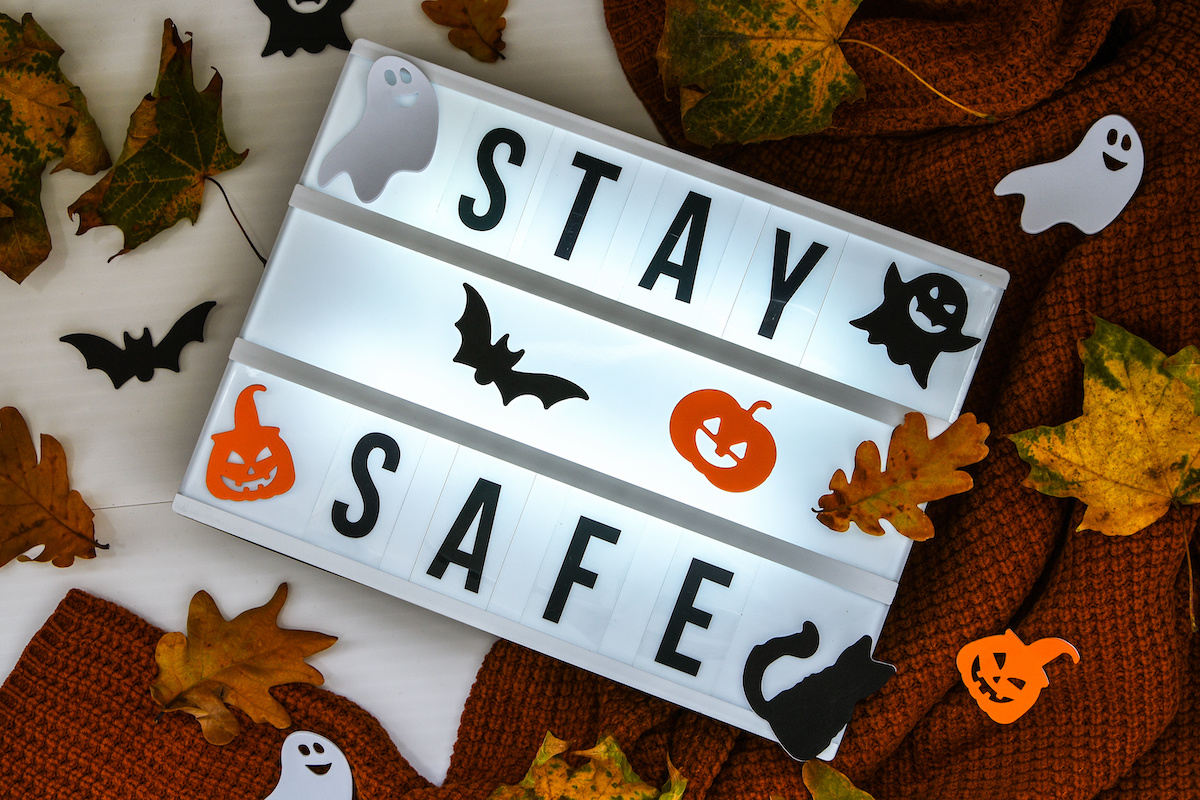There are many reasons we welcome fall with open arms. But the thing your child might be most excited about in October is Halloween. And why shouldn’t they be? Halloween is one of the most fun holidays for children. To get the most out of the holiday, Halloween safety should be top of mind for kids and parents.
Halloween Safety Tips
As with any big occasion, there are dangers to look out for during Halloween, especially when it comes to trick-or-treating. Following the American Academy of Pediatricians’ lead, we’ve come up with a helpful list of the dos and don’ts of trick-or-treating to keep everyone safe and happy on the holiday.
1. Set Ground Rules
If you have an older child who is trick-or-treating with a group of friends, or if your child is going around with another adult you trust, make sure they (and the responsible adults) know your rules. This can include rules about COVID safety, eating candy, safety rules, and when they need to be home.
2. Follow COVID Safety Guidelines
The COVID-19 pandemic has touched every part of our lives, and how to safely celebrate Halloween has changed. The AAP has more detailed COVID-19 safety guidelines for Halloween, but we’ll go over the basics.
Since trick or treating is usually an outdoor endeavor, that makes things a little easier. For Halloween parties, pumpkin carving, and other activities, try to stay outside as well. If you do go to an indoor event, follow guidelines for masking, especially with people who are unvaccinated or if you live in a high-risk area.
3. Kids Under 12 Trick-or-Treat Need Adult Accompaniment
You or your partner may trick-or-treat with your children each year, which is a great choice. You can also join up with other friends with children to trick-or-treat as a group with multiple adults to supervise. If you won’t be with your child and they are younger than 12, make sure they are with at least one trusted adult. Children 12 and older should still go with a group (friends that you know well or other older siblings). Set specific guidelines on where they are allowed to go, when they need to check in, and what time they need to come home.
3. Take Safety Precautions
Even when you are with your child, there are some things that pose risks during trick-or-treating. The biggest risk factors are that it’s dark and there may be moving vehicles where you are trick-or-treating. Safety precautions you should take include:
- Review all of your safety rules with children and make sure they know why they are important.
- Use bright colors in costumes when possible.
- Use flashlights and have them available for children if needed.
- Pin a tag with your child’s name and contact information to their costume in case you get separated.
- Consider using reflective tape or glow sticks on costumes, shoes, or bags to make them visible to cars.
- Enforce the “look both ways” rule when crossing the street. Also make sure they stay aware of their surroundings, especially when near roads where there are cars driving (even at the slow speeds required in residential areas).
4. No Homemade Treats from Strangers
Unless you know someone very well and trust them, do not let your child eat homemade candy or other sweets on Halloween. Most people do not have malicious intent when handing out homemade treats, but they could contain ingredients that may cause an adverse reaction or illness.
5. Pay Attention to Costume Safety
Dressing up is a big part of Halloween fun. So, it makes sense that part of Halloween safety is making sure costumes are safe.
- Make sure your child’s costume fits correctly. Hem pants and skirts to avoid tripping. Avoid costumes that are too tight and can be uncomfortable to wear for an extended period.
- Make sure your child’s shoes are comfortable and suitable for walking in. Avoid high heels, plastic slippers, or other flimsy footwear that can cause injury.
- Make sure your child is warm enough in their costume. If it’s chilly, they can wear layers underneath for insulation and if it’s cold enough, you can require them to wear a jacket. Also, make sure they won’t overheat if you live in a place that might be warm on Halloween.
- Only allow costumes made with non-flammable fabric.
- Attach reflective material to the costume.
- Avoid masks that may impair breathing or vision.
- Insist that your child wear their glasses if they require vision correction. They might argue that glasses don’t “go with” their costume, but being able to see clearly is non-negotiable.
6 Monitor Candy Consumption
For a child, one of the ultimate goals of Halloween is collecting a big bag of candy and treats. And it is generally fine to allow your child to indulge their sweet tooth occasionally. However, you need to make sure they do not eat too much at one time and that the things that they do eat are safe. Some guidelines to follow when it comes to Halloween candy:
- Do not let children eat a lot of candy as they trick-or-treat. If you inspect the candy carefully, it might be fine to give them a couple of pieces as they go along, but avoid letting them have too much and never let them eat something that you haven’t checked. It is recommended that you have children eat a healthy dinner before going out to trick-or-treat, even if it’s earlier than usual.
- Ration their candy. Don’t let kids just take the whole bag or bucket up to their room and leave them to their own devices. They might not be able to grasp the benefits of moderation. Instead, keep the candy in a safe place where kids can’t get to it and give them a few pieces every now and then as a treat. If you’d rather not have your child have the candy at all, you may be able to negotiate a trade for something else they like. Things they might be willing to swap candy for are small toys, books, or special outings.
- Inspect all candy before allowing children to eat it.
7. Make Your Own Home Safe for Trick-or-Treaters
While you may be focused on your own child’s safety, some dos and don’ts of trick-or-treating apply to keeping other children safe on your property. This is especially applicable if you will be passing out candy.
- Clear your yard and walkways of any tripping hazards and debris that could cause slipping.
- Make sure your walkway and porch are well-lit. Replace burned-out bulbs and make sure the lights are switched on during the hours trick-or-treaters might come.
- Control your pets and do not take any chances that a pet might frighten or be aggressive towards a child. It can also be a problem if your pet is prone to bolting when the door is open. You may want to leave pets in a fenced-in yard during peak trick-or-treating hours or keep them in a room or gated area where they can’t get to the door. If your pet is anxious, they may feel safest in their crate or bed. You are probably the best judge of your pet’s personality and tendencies but exercise extreme caution when it comes to children they aren’t familiar with.
Talk to a Pediatrician
The providers at Wake Forest Pediatrics strive to improve patient care by strengthening the patient-doctor relationship, providing open communication, and working as a team for a comprehensive approach to medical care. To talk to our team about keeping your child safe and healthy year-round, call our Wake Forest office at 919-556-4779 or our Knightdale office at 919-266-5059 to make an appointment.




